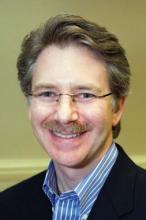CHICAGO – Big Data promises better outcomes and cost savings but begs the question of how much privacy patients are willing to give up.
Via smart phones and cloud computing, hyperspecific information on individual patients can be gathered 24 hours a day, 7 days a week from GPS location, photographs, audio, and other forms of monitoring. Blood pressure, weight, and even pulse detection are already being tracked in some patients. Using advanced algorithms, patient alerts can identify those at risk and possibly allow early interventions that avoid critical events and reduce the cost of care.
"The question is, ‘How much do [patients] want to be monitored?’ " asked Dr. Burt Lesnick, FCCP, of Georgia Pediatric Pulmonary Associates, Atlanta, during a presentation at the annual meeting of the American College of Chest Physicians. Monitoring can assist patients in managing their illness; but empowerment that comes at the cost of constant surveillance "sounds very Orwellian," he said.
Dr. Lesnick has even observed the power of mobile technology to improve asthma control in his own practice. In two small controlled studies, he and his associates randomized a total of 100 children who had asthma and owned a cell phone into three groups. The control group did not receive any communication from the physician. The second group was surveyed by e-mail every 4 days to assess their asthma control scores. If responses indicated an increase in risk, the clinical staff would call the family to discuss the child’s risk status.
The third group also received the rolling assessments, as well as text messages that quizzed their asthma knowledge with true/false questions. Patients who answered the prompts correctly were rewarded with a text message, "You’re right!" and an explanation of why they were correct. If they answered incorrectly, they were told, "Not quite," and also given an explanation.
Dr. Lesnick’s first study included 40 children. In his second study, 60 children were randomized in similar fashion. However, an additional factor – whether patients had public or private insurance – also was used for randomization. Furthermore, the second study addressed whether the success of the combined assessment/knowledge group could be attributed to the increased volume of text messages in that group. The researchers examined whether the text messages created a "reminder" effect for the children to take their medications.
In each study, the groups given rolling assessments and education had significant improvements in forced expiratory flow (FEF25-75%) over baseline measures.
In the first study, the FEF25-75% scores rose from a baseline average of 74.3 plus or minus 31.4 to a poststudy average of 96.0 plus or minus 32.6 in the group given assessments and education. No statistically significant differences in FEF25-75% were seen in the other two groups. In the knowledge-only group, FEF25-75% scores increased from 78.2 plus or minus 32.0 to 84.2 plus or minus 31.7. In the control group, the FEF25-75% scores decreased from 91.1 plus or minus 26.6 to 73.5 plus or minus 27.5.
In the second study, which included equal numbers of children on public and private insurance, the FEF25-75% scores in the education group went from 51.3 plus or minus 21.0 at baseline to 65.5 plus or minus 25.7 at post study.
"Kids were much better reporters of their asthma symptoms with exercise than their parents were," Dr. Lesnick noted. "Not a great surprise, but an important point."
There was a direct correlation between children being put in charge of learning about and managing their asthma, versus relying on their parents to do it for them.
"We were getting them to be empowered ... because we were talking to them in their language: text messages. That’s how they communicate." said Dr. Lesnick.
But how much intrusion will patients be willing to accept in the future to gain "empowerment"? And how much of their information should be shared – and in what manner?
States are eager to use Big Data to drive down health care costs as they compete for federal health dollars based on quality improvements derived from this data, Dr. Lesnick noted. Meanwhile, private insurers are particularly interested in tracking who is most mindful of their health since aggregating this data helps to stratify risk.
Similar to how the auto insurance industry has recognized customers’ willingness to have devices installed in their cars to monitor their driving habits in exchange for lower premiums, health insurers are willing to bank on the notion that people who know they are under observation will change their behavior, Dr. Lesnick said.


